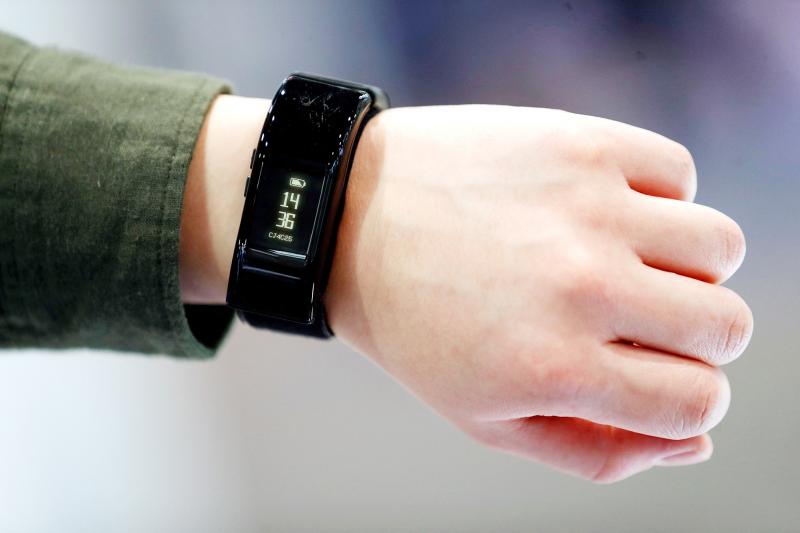A ring shimmers on display at the Consumer Electronics Show, but this is no mere piece of jewelry — it’s packed with sensors capable of detecting body temperature, respiration and much more.
Startups at the annual gadget extravaganza in Las Vegas touted technology-enhanced accessories designed to look fetching on the outside while scrutinizing what is happening on the inside of wearers.
“We want to democratize personal health,” said Amaury Kosman, founder of the French startup that created the Circular Ring.

Photo: Reuters
While that goal was shared by an array of exhibitors, some experts worried a trend of ceaselessly tracking steps, time sitting, heart rate and more could bring risks of stress and addiction.
Circular Ring provides a wearer with a daily “energy score” based on the intensity of their activity, factoring in heart rate, body temperature, blood oxygen levels and other data, according to Kosman.
“At night it continues, we track the phases of sleep, how long it takes you to fall asleep, if you are aligned with your circadian rhythm, etc,” he said of the ring, which will cost less than 300 euros (US$340) when it hits the market later this year.

Photo: Reuters
“And in the morning it vibrates to wake you up at the right time.”
A mobile application synced to the ring is designed to make personalized lifestyle recommendations for improving health based on data gathered, according to the founder.
HIGH DEMAND FOR WEARABLES
Demand for body-tracking “wearables” is strong: CES organizers forecast that more than US$14 billion will be spent this year in a category that includes sports tech, health-monitoring devices, fitness activity trackers, connected exercise equipment and smartwatches.
That figure is more than double what was spent in the category in 2018.
Growth has been driven by smart watches such as those made by powerhouses Apple and Samsung, as well as internet-linked sports gear — which boomed during the pandemic — and personal tracking devices.
Companies are also moving to fill a need for instruments that provide data that can be relied on as part of a pandemic-driven trend of remote health care.
Swiss Biospectal taps into smartphone cameras to measure blood pressure when a finger is placed over a lens.
French Quantiq is developing algorithms that calculate heart rate, respiratory rate and blood pressure from “selfies.”
Meanwhile, Japanese start-up Quantum Operation has designed a prototype bracelet that continuously measures the level of glucose in the blood. Diabetic patients would be spared needle jabs for frequent blood sugar tests.
Body-minding wearables can provide valuable health data, but some fear a “quantified self” trend is blurring the line between well-being and stressful obsession.
GROWING DEPENDENT?
South Korean firm Olive Healthcare displayed a “Bello” infrared scanner that analyzes stomach fat and suggests how to lose it, along with a “Fitto” device that assesses muscle mass and ways to increase it.
Society needs to determine whether these kinds of tools solve problems or “give rise to new dependencies,” contended German political scientist Nils-Eyk Zimmermann.
A danger is that the “digital self” generated by such technology does not match reality, reasoned Zimmermann, who blogs on the topic.
He also saw danger in “game” features, such as rewards and peer competition that put pressure on users that may not be healthy.
Withings’s US sales director Paul Buckley was confident people can handle health data made available from devices such as the Body Scan smart scale unveiled at CES by the French company.
“I don’t think it’s too much,” Buckley said as he showed off the scale capable of performing electrocardiograms and analyzing body composition.
“You’re able to be more informed about what is going on in your body.”

The Nuremberg trials have inspired filmmakers before, from Stanley Kramer’s 1961 drama to the 2000 television miniseries with Alec Baldwin and Brian Cox. But for the latest take, Nuremberg, writer-director James Vanderbilt focuses on a lesser-known figure: The US Army psychiatrist Douglas Kelley, who after the war was assigned to supervise and evaluate captured Nazi leaders to ensure they were fit for trial (and also keep them alive). But his is a name that had been largely forgotten: He wasn’t even a character in the miniseries. Kelley, portrayed in the film by Rami Malek, was an ambitious sort who saw in

Last week gave us the droll little comedy of People’s Republic of China’s (PRC) consul general in Osaka posting a threat on X in response to Japanese Prime Minister Sanae Takaichi saying to the Diet that a Chinese attack on Taiwan may be an “existential threat” to Japan. That would allow Japanese Self Defence Forces to respond militarily. The PRC representative then said that if a “filthy neck sticks itself in uninvited, we will cut it off without a moment’s hesitation. Are you prepared for that?” This was widely, and probably deliberately, construed as a threat to behead Takaichi, though it

Among the Nazis who were prosecuted during the Nuremberg trials in 1945 and 1946 was Hitler’s second-in-command, Hermann Goring. Less widely known, though, is the involvement of the US psychiatrist Douglas Kelley, who spent more than 80 hours interviewing and assessing Goring and 21 other Nazi officials prior to the trials. As described in Jack El-Hai’s 2013 book The Nazi and the Psychiatrist, Kelley was charmed by Goring but also haunted by his own conclusion that the Nazis’ atrocities were not specific to that time and place or to those people: they could in fact happen anywhere. He was ultimately

Nov. 17 to Nov. 23 When Kanori Ino surveyed Taipei’s Indigenous settlements in 1896, he found a culture that was fading. Although there was still a “clear line of distinction” between the Ketagalan people and the neighboring Han settlers that had been arriving over the previous 200 years, the former had largely adopted the customs and language of the latter. “Fortunately, some elders still remember their past customs and language. But if we do not hurry and record them now, future researchers will have nothing left but to weep amid the ruins of Indigenous settlements,” he wrote in the Journal of